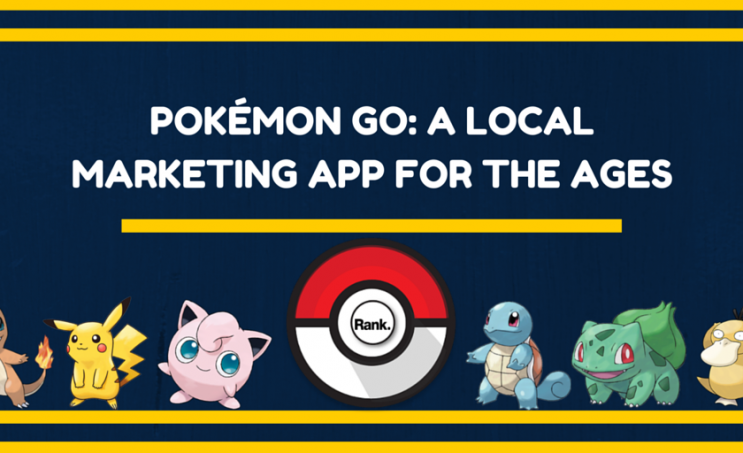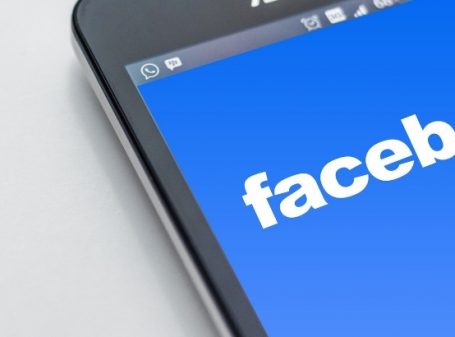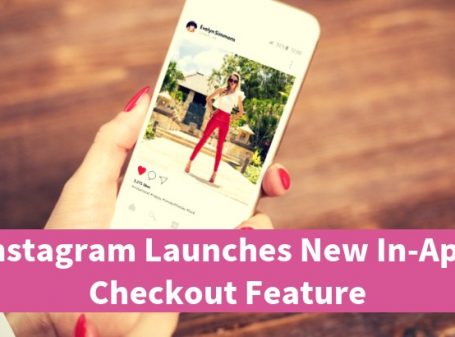Pokémon Go: A Local Marketing App for the Ages
By: Rank Media

Gotta catch ’em all, right? That’s the mentality millions around the world have adopted over the past two weeks as the latest mobile gaming fad, Pokémon Go, has invaded homes, streets, pop culture, and more. Sick of hearing about the Pokémon hype? I’ve got bad news for you – you’re not going to enjoy this post. However, if you’re looking for innovative local marketing tactics to attract more street traffic, then you may have to hop on the Pokémon train.

Pokémon Go Background & Launch
For those of you unfamiliar with the mobile application, it is a “free-to-play location-based augmented reality mobile game” developed by Niantic, an American software development company based out of San Francisco, California. Yes, “free-to-play location-based augmented reality mobile game” is quite a mouthful, but it accurately summarizes the game for the uninitiated. Niantic developed the game with The Pokémon Company, which is owned by three parent companies: Creatures Inc, Game Freak Inc, and the well-known gaming/software developer, Nintendo.
Initially launched in three regions (Australia, New Zealand, and the United States) on July 6, 2016, the mobile game quickly shot up app store rankings and became a worldwide sensation overnight. The game itself is quite basic and can be played by people of all ages, requiring no payment information to get going. Of course, there are upgrades available within the app’s store, but that’s only if you get tired of walking around and want to expedite your ability to find new items. In terms of gameplay, below is an overly simplified list of things you can do:
- Walk around and visit “PokéStops”, where you can find items to assist your character development.
- Find Pokémon in the wild and try to catch them.
- Level up and eventually choose a team (Mystic, Instinct, or Valor)
- Either train or battle other teams at gyms.
- Find more Pokémon…seriously, where the heck are you, Pikachu?

Impressive Statistics Behind the Mobile Application
Immediately upon release, Pokémon Go has become a mobile application for the ages. Below are some powerful and salient stats that cement Pokémon’s place within pop culture and the record books:
- The application hit #1 on both Google Play and the App Store within one day of its launch. (SimilarWeb)
- An estimated $14 million in revenue was generated within one week of the launch. (SuperData Research)
- Users spend an average of 33 minutes per day engaged with the app, eclipsing notorious social media applications such as Facebook, Instagram, and Snapchat. (SensorTower)
- Nintendo’s stock increased by 86% in 10 days, representing an increase of $17 Billion in its market cap. (Reuters)
- Pokémon Go currently has more daily active users in the United States than Tinder, Twitter, and Google Maps. (SimilarWeb)
- Application retention rates average 70%, nearly double the industry standard for mobile games. (SurveyMonkey)
- The average revenue per user is $0.25, which is double the industry average for mobile games. (SurveyMonkey)
- It has officially become the biggest mobile game in United States history, cruising past Candy Crush’s record peak of 21 million users. (SurveyMonkey)
And that’s just the tip of the iceberg.
Pokémon Go for Local Marketing…Seriously?
If you’re thinking about leveraging the success of Pokémon go for local marketing initiatives, then you’re right on the money. Not only is there a record-breaking amount of users downloading the app, but players are highly engaged within each session, walking the streets of their cities & regions to find elusive and rare characters. Within the game, many local businesses and landmarks have already been designated as PokéStops and Gyms, which will attract gamers naturally as players can pick up items and battle against other users within the game. In order to take advantage of this mobile app, you can either promote your location’s PokeStop (if you have one) or purchase Lure Modules, which are setup to attract “rare and wild” Pokémon for thirty minutes. Here is an example of how purchasing Lure Modules can be an affordable option for a local business:
- A Lure Module can be acquired at 100 “Pokécoins“, the game’s native currency for items within the app’s shop.
- Alternatively, you can acquire a pack of eight modules for 680 coins, representing a volume discount.
- 100 Pokécoins can be purchased for $0.99 USD, with volume discounts bringing the costs down considerably if you spend $99.00 (at which level you can acquire 14,500 Pokécoins).
- Promote the use of Lure Modules via social media channels and street signage to attract fans and passer-bys.
- Offer discounts and/or special promotions for Pokémon Go players.
- Watch the money roll-in on a cost-effective budget. Well, not really, but you’ll have the opportunity to catch new customers, not Pokémon.
Of course, that’s the ideal situation. The flip-side is that you purchase $99.00 worth of Pokécoins to acquire Lure Modules and no one comes by your establishment. However, there are stories of many local businesses in various markets utilizing the latest mobile gaming craze to attract clients and boost business, so it’s worth the small investment to capture new customers.

How to Promote Pokémon Go Usage Locally
In addition to purchasing Lure Modules, here are some handy strategies you can employ to bring users to your local establishment:
- Create a Pokémon Go event on Facebook and promote the event via Facebook Ads.
- Initiate Twitter chats in your local area to discuss tips, tricks, and more.
- Encourage users to follow you on Snapchat to get exclusive updates on when Lure Modules will be used.
- Publish content to Instagram with local hashtags to maximize coverage of your Pokémon Go events.
- Provide discounts and/or promotions to users that are part of a specific team.
- Help users hatch their eggs by carrying the phone around (I kid you not – hatching eggs is part of the game).
The possibilities are endless and this is the perfect time for experimenting , especially before most users become bored of the game. Of course, there is a large contingent of die-hard Pokémon fans that will keep up with the game for months, but it’ll be interesting to see the lasting power among casual users over the next couple of months.
In the meantime, if you haven’t downloaded the application yet, it might be time to try it out and see how it can help your local marketing initiatives. Who knows, maybe you’ll have some fun catching Pokémon.








 (800) 915 7990
(800) 915 7990
